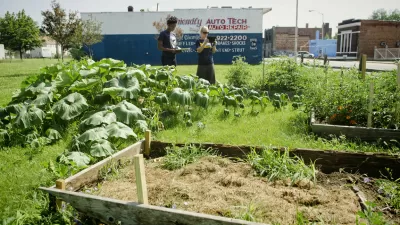Lessons from a successful urban farming effort can be applied to achieve resource independence aside from just food.

Though Cuba's urban farming efforts were caused by severe food shortage as a result of the collapse of the Soviet bloc and end of trade, Carey Clouse shows that the country's combined grassroots movement and top-down urban farming policies can be employed by other communities seeking food or other resource independence.
Combatting food shortage required “prioritising organic farming methods,” government-sponsored “training and support, hosting many dozens of subsidised agricultural stores, three compost production sites, seven artisanal pesticide labs and 40 urban veterinary clinics,” as well as community “guerrilla gardening initiatives [that] blossomed into new state-supported urban farming programmes.”
One of the successes of Cuba's agricultural resurrection is its “systematic approach to rethinking urban landscapes for more productive means: food production infrastructure has been woven into the city fabric, with interventions that range in size from backyard gardens to large peri-urban farms.” The ability to seize an agricultural opportunity at every scale is evident as food is grown in “balcony garden to the multi-hectare fields that comprise Havana’s greenbelt” to “vacant and blighted properties within the city...demonstrat[ing] that productivity can be infused into hardened urban landscapes.”
FULL STORY: Cuba’s Urban Farming Revolution: How to Create Self-Sufficient Cities

Planetizen Federal Action Tracker
A weekly monitor of how Trump’s orders and actions are impacting planners and planning in America.

Maui's Vacation Rental Debate Turns Ugly
Verbal attacks, misinformation campaigns and fistfights plague a high-stakes debate to convert thousands of vacation rentals into long-term housing.

Restaurant Patios Were a Pandemic Win — Why Were They so Hard to Keep?
Social distancing requirements and changes in travel patterns prompted cities to pilot new uses for street and sidewalk space. Then it got complicated.

In California Battle of Housing vs. Environment, Housing Just Won
A new state law significantly limits the power of CEQA, an environmental review law that served as a powerful tool for blocking new development.

Boulder Eliminates Parking Minimums Citywide
Officials estimate the cost of building a single underground parking space at up to $100,000.

Orange County, Florida Adopts Largest US “Sprawl Repair” Code
The ‘Orange Code’ seeks to rectify decades of sprawl-inducing, car-oriented development.
Urban Design for Planners 1: Software Tools
This six-course series explores essential urban design concepts using open source software and equips planners with the tools they need to participate fully in the urban design process.
Planning for Universal Design
Learn the tools for implementing Universal Design in planning regulations.
Heyer Gruel & Associates PA
JM Goldson LLC
Custer County Colorado
City of Camden Redevelopment Agency
City of Astoria
Transportation Research & Education Center (TREC) at Portland State University
Jefferson Parish Government
Camden Redevelopment Agency
City of Claremont



























